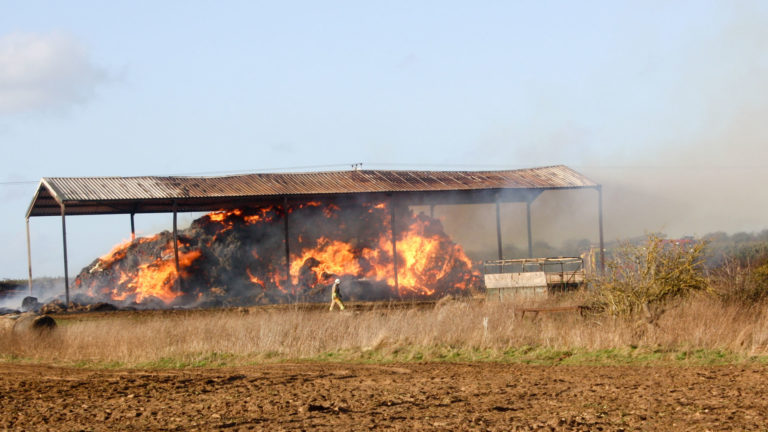Reducing and insuring against farm fire risks

Figures show that more than 1500 farm buildings are devastated by fire every year and shockingly, around 40% of farm fires are caused by acts of vandalism. Needless to say, the destruction of land, crops, and livestock by fire can be catastrophic and up to 80% of farms are left facing serious difficulty after suffering a major fire.
- Who is responsible for completing a farm fire risk assessment?
- What are the main causes of farm fires?
- What should a fire risk assessment include?
- Tips to prevent farm fires
- How insurance can help mitigate financial loss from a farm fire
Here, we explore where responsibility for preventing farm fires lies, how to reduce the risk of a farm fire, and how insurance can help minimise your financial losses.
Who is responsible for completing a farm fire risk assessment?
The Fire Safety Order 2005 is the main piece of fire legislation that applies to almost all businesses in England and Wales – including farms.
Under the rules, farm owners and managers are considered responsible for making sure fire safety measures are in place. This includes carrying out a fire risk assessment, identifying hazards and putting safeguards in place. However, in the case of farm tenancies, building owners and employees are also expected to bear responsibility for ensuring that fire safety rules are followed.
What are the main causes of farm fires?
Fires can start for all sorts of reasons, but experts have identified three main causes of farm fires, which are:
- Arson
- Hot works (such as welding and grinding)
- Electrics
While accidents are unavoidable, you can lower the risk of a farm fire by carrying out a fire risk assessment. It’s recommended that you review your assessment on a regular basis, ideally annually. It’s also a good idea to completely re-evaluate it every four to five years to ensure it’s still fit for purpose.
What should a fire risk assessment include?
Your fire risk assessment is simply about identifying potential hazards and making judgments about how you can cut the risk of a farm fire starting. It’s important to note that any businesses with five or more people must have a written record of their fire risk assessment.
There are five key areas to consider when you carry out your fire risk assessment. You can download a checklist from GOV.UK but your assessment must:
1. Identify fire hazards such as:
- ignition and how a fire might start;
- fuels kept on the farm, where they are and how easy they are to get hold of;
- dangerous flammable substances.
2. Identify any people at risk, including:
- Employees;
- anyone with access to farm buildings (for example, customers if you run a farm shop);
- children or anyone vulnerable who may need help with mobility;
- Emergency services, for example, for site accessibility.
3. Evaluate, remove or reduce the risks:
- assess the risk of a fire starting;
- consider what risks there are to people if a fire started;
- think about how to mitigate the risk of a fire (for example, removing potential sources of ignition and keeping fuel locked away);
- think about how to minimise harm to people (such as smoke alarms, fire extinguishers, escape routes, clear signage).
4. Record your findings, prepare an emergency plan and provide training:
- make a note of anything significant or any actions you’ve taken;
- use the information you’ve collected to create an emergency plan;
- share your plans and assessments with employees and any other relevant people;
- make arrangements for appropriate training.
5. Review and update your fire risk assessment regularly:
- check your fire risk assessment annually and update it if needed.
For further assistance in carrying out a fire safety risk assessment, contact Alan Boswell Risk Management on 01603 967900.
Tips to prevent farm fires
Focusing on the five key principles of your fire risk assessment will enable you to think about fire hazards objectively. Nevertheless, it’s good practice to make fire prevention an everyday consideration; here are some of our tips that can help reduce the risk of a fire starting on your farm:
Security and arson prevention
-
-
- Is trespassing an issue (or potentially an issue) and how can this be minimised?
- Think about ways to cut rural crime by investing in fencing, locks, floodlights.
- Install CCTV if feasible.
-
Storage safety
-
-
- Hay and straw should be stored as soon as possible after harvesting and kept separate and away from other buildings.
- Fuel and other flammable liquids and substances should be kept in a lockable container and out of sight.
- Rubbish and waste should be regularly removed and kept to a minimum.
-
Electrical safety
-
-
- Electrical safety checks should be carried out regularly, including on hot works equipment and machinery.
- Appliances in farm buildings should also be tested and meet safety standards.
-
General fire safety management
-
-
- Keep farm firefighting equipment and fire extinguishers regularly checked and on hand.
- Ensure smokers know to dispose of cigarettes safely.
- If you provide camping facilities, have clear guidance on barbecues and campfires and ensure areas are regularly checked and monitored.
- Make sure water supplies are accessible in case a fire does occur.
- Exits and routes should be clearly marked as part of your general risk management.
-
How insurance can help mitigate financial loss from a farm fire
Sadly, you can’t plan for the unpredictable which is why it’s crucial to have farm insurance you can rely on.
At Alan Boswell Group, farm and agriculture insurance is one of our fields of expertise and we understand just how complex and nuanced the industry really is. As specialists, we can take you through what you should consider and set out options based on your specific farm business needs.
For example, policies can cover you for loss of revenue if there were delays harvesting because of an event you were insured for. Similarly, farm insurance can also cover costs if you needed to hire replacement or additional machinery to prevent crop loss.
Also remember that farm insurance (like all policies) will come with certain conditions. For instance, many insurers will limit stack height for hay and straw bales. Exceeding this height can risk invalidating your policy. However, as experts in farm insurance we can discuss this with you when considering the best policy for your risks.
For more information, speak to one of our expert team members on 01603 218000.




